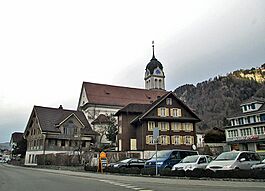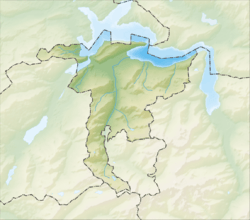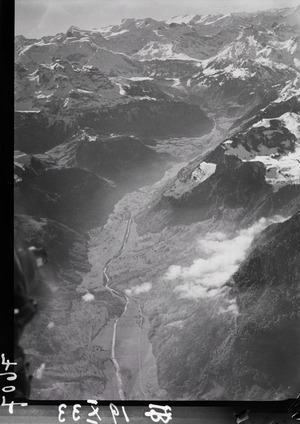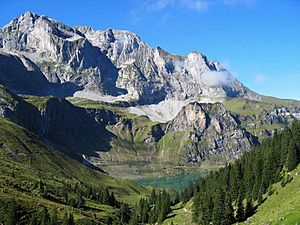Wolfenschiessen facts for kids
Quick facts for kids
Wolfenschiessen
|
||
|---|---|---|
 |
||
|
||
| Country | Switzerland | |
| Canton | Nidwalden | |
| District | n.a. | |
| Area | ||
| • Total | 92.7 km2 (35.8 sq mi) | |
| Elevation
(Wolfenschiessen village)
|
510 m (1,670 ft) | |
| Highest elevation
(Titlis Glacier)
|
2,880 m (9,450 ft) | |
| Lowest elevation
(Niederrickenbach Station)
|
488 m (1,601 ft) | |
| Population
(Dec 2020 )
|
||
| • Total | 2,115 | |
| • Density | 22.816/km2 (59.09/sq mi) | |
| Postal code |
6386
|
|
| Surrounded by | Beckenried, Dallenwil, Engelberg (OW), Innertkirchen (BE), Isenthal (UR), Kerns (OW), Oberdorf | |
Wolfenschiessen is a village and a type of town called a municipality in the canton of Nidwalden in Switzerland. Besides the main village of Wolfenschiessen, this area includes smaller places like Altzellen, Büren ob dem Bach, Dörfli, and Oberrickenbach. It also has a large area of high mountains, beautiful lakes, and even glaciers.
Contents
- A Look Back: History of Wolfenschiessen
- What's in a Name? The Coat of Arms
- Exploring the Land: Geography of Wolfenschiessen
- People of Wolfenschiessen: Demographics
- Learning and Working: Education and Economy
- Getting Around: Transport in Wolfenschiessen
- Places to See: Sights and Heritage Sites
- Images for kids
- See also
A Look Back: History of Wolfenschiessen
Wolfenschiessen was first written about around the year 1200. However, older records from about 1160 also mention fields in the area.
Early Owners and the Wolfenschiessen Family
In the 1100s, the farms and fields of Wolfenschiessen were owned by a group of monks called the Benedictine Muri Abbey. Over time, in the 1200s and 1300s, parts of the land were given to other abbeys, like Murbach-Lucerne and Engelberg Abbey.
Around the same time, a family called von Wolfenschiessen became important. They likely started as farmers but then became minor nobles. They were put in charge of managing the monastery's lands in Wolfenschiessen. This family built a tower in the middle of the village. From this tower, they managed and ruled the village and its farms. The von Wolfenschiessen family became very well-known locally. However, they lost most of their wealth and power in the 1400s and eventually died out by the early 1600s.
Village Church and Growth
A church was built in the village by 1277. At first, it was a smaller church connected to the main parish church in Stans. But in 1438, Wolfenschiessen got its own priest, and by 1469, it became its own independent church area, called a parish. During the 1300s to 1500s, several other small villages, or hamlets, grew up around Wolfenschiessen.
What's in a Name? The Coat of Arms
The coat of arms for Wolfenschiessen shows a blue shield with a silver wolf. An arrow is shooting through the wolf. This is a special type of coat of arms called "canting". It means the picture on the shield helps explain the name of the place. In this case, "Wolfenschiessen" means "to shoot the wolf."
Exploring the Land: Geography of Wolfenschiessen
Wolfenschiessen is located on both sides of the deep valley of the Engelberger Aa river. This river flows from Engelberg downwards. The area also includes high alpine regions that surround Engelberg to the north, west, and south. The main settlements of Wolfenschiessen, Büren ob dem Bach, and Dörfli are in the valley. Altzellen and Oberrickenbach are on higher ground to the east.
Lakes and Mountains
The beautiful lake Bannalpsee is located above Oberrickenbach, north of Engelberg. Another lake, the Trüebsee, is found on high ground south of Engelberg. The very southern part of the municipality reaches high up the side of the Titlis mountain. It even includes a part of the Titlis Glacier, which is a large area of ice.
Land Use
Wolfenschiessen covers an area of about 92.76 square kilometers (35.8 square miles). A large part of this land, about 39.6%, is used for farming. Forests cover about 33.6% of the area. Only a small part, 1.4%, has buildings or roads. The remaining 25.4% is unproductive land, like rocky mountain areas.
People of Wolfenschiessen: Demographics
Wolfenschiessen has a population of about 2,136 people (as of December 2016). About 10.8% of the people living here are foreign nationals. The population has grown by about 7.13% in the last five years (2010-2015).
Age Groups and Households
As of 2015, children and teenagers (ages 0–19) make up 24.4% of the population. Adults (ages 20–64) are 60.6%, and seniors (over 64) are 15.0%. In 2015, there were 819 private households in Wolfenschiessen. On average, each household had about 2.59 people.
Many people in Wolfenschiessen speak German, which is the main language for 93.6% of the population. Albanian is the second most common language (2.7%), followed by Serbo-Croatian (1.4%).
The number of people living in Wolfenschiessen has changed over time:

Learning and Working: Education and Economy
Many adults in Wolfenschiessen (between ages 25-64) have finished either high school or gone on to higher education, like university.
Local Jobs
Wolfenschiessen is a community where both farming and manufacturing are important for the economy. In 2014, there were 870 people working in the municipality.
- About 229 people worked in 86 businesses related to farming and natural resources (the primary economic sector).
- Another 267 people worked in 31 businesses that make things (the secondary sector).
- Finally, 374 jobs were in the service industry, like shops, hotels, and offices (the tertiary sector).
In 2015, hotels in Wolfenschiessen had over 22,000 overnight stays. About one-third of these visitors were from other countries.
Getting Around: Transport in Wolfenschiessen
The municipality of Wolfenschiessen has two train stations on the Luzern–Stans–Engelberg railway line. These are Wolfenschiessen station and Niederrickenbach station. Trains run hourly between Luzern and Engelberg, stopping at both stations. There is also a local train service (S4) from Luzern that ends at Wolfenschiessen.
A Swiss PostBus service connects the villages of Wolfenschiessen and Oberrickenbach. From Oberrickenbach, you can take a cable car up to the beautiful Bannalpsee. Many other cable cars in the area help people reach higher homes, farms, and tourist spots on both sides of the valley.
On the mountain pasture called Ober Trüebsee, you'll find the lake named Trüebsee. At one end of the lake, there's a stop on the cable car system that connects Engelberg to the top of Klein Titlis mountain.
Places to See: Sights and Heritage Sites
Wolfenschiessen has several interesting places to visit. The main sights include the St. Maria parish church and the St. Joder chapel in Altzellen. There are also two old mansions called Hechhuis and Grossitz.
Important Heritage Sites
Several buildings in Wolfenschiessen are listed as important heritage sites of national significance in Switzerland. These include:
- The farmhouses Grossitz (at Hauptstrasse 31)
- Unteres Brunnifeld (at Hauptstrasse 41)
- The Hechhuis or Lussyhaus mansion
- The house Hofstatt im Dörfli
Images for kids
See also
 In Spanish: Wolfenschiessen para niños
In Spanish: Wolfenschiessen para niños















